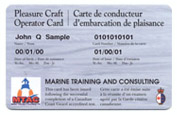Types of Vessels
Online Course Home
Displacement and Planning Vessels
Dispacement hulls must displace the same volume of water as the portion of the hull that is underwater. As these boats move through the water they create a bow wave.
Planing Vessels also displace an equal amount of water when stopped, however, when the speed of a planing vessel is increased, the bow lifts up onto its bow wave and skims the surface of the water. It is supported by water and air.
Identifying Types of Vessels

Runabout is a general term describing small open boats, generally without cabins and with little or no deck. They are usually powered by outboard engines..

Powerboats vary greatly in variety due to hull shape and deck configuration. This class of vessel is also open cockpit in design and generally used for day trips. Propulsion systems are either inboard, outboard or water jet powered.

Cruisers are power boats with internal accomodations or cabins. There are several types of cruisers, and they are identifiable by their hull shape and superstucture (external cabin appearance).

Flying Bridge Cruisers have a control bridge distinctively placed on top of the main superstructure of a cruiser to provide a protected area with a good field of view from which the vessel can be controlled.

Personal Water Craft (PWC) are considered boats under waterway rules. Individuals under the age of 16 are not permitted to operate PWC's in Canadian waters.
